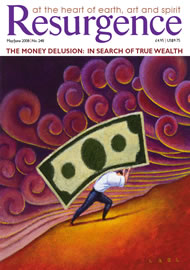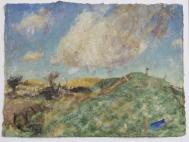Two years ago, Daniel Chatto started spending what he calls “chunks of time” living and painting on the Sussex Downs. Though for most of the year this London-born painter is based in the capital, he finds the Downs subtly and radically inspiring. This has helped release a flow of small-scale, vividly luminous paintings on sturdy, handmade Indian paper.
For Chatto, the chalk escarpment of the Downs (a word deriving from the old English dun, meaning ‘hill’) is a territory of magical intimacy. “I love actually being in the country and people there still having this amazing insularity.” He responds especially to the Downs’ timeless contemporary nature because, since it is “marginal land, it can’t be ploughed up. Thank God you still have to leave the sheep on the hill, and people still do wander about and go to sleep under a tree, with visions in their head. A lot of farmers there now are being paid by the government to put the land down to grass again and have pigs in winter to rootle about, and allow flowers to grow into the grasses. I think they are trying to make the landscape more like it was. They are thinking like painters in a way.”
Compared to his earlier darkly intense paintings set in India, with women in hallucinatorily brilliant saris and men in earth-toned, elegant dhotis, the ‘Downs’ series is serenely radiant and relatively unpeopled. In Big Church Field, the person in blue gently propped up against a tree is “a sleeping figure but surrounded by sheep so we’ll call him a shepherd”. The figure in his purplish blue garb (beautifully distinct from all else in this dusk landscape of pale greens and browns and chalky greys) is as fluid as the curving, vertiginous hills, the meandering vale and the burgeoning tree form. His secret dream or vision is inseparable from the encircling, glowing landscape, its resident sheep alertly sentient to the new day.
Chatto was born in 1957 and studied English Literature at New College, Oxford in the late 1970s, after a one-year Art Foundation Course at London’s City and Guilds. He is inspired by a love of poetry ranging from early English lyrics (“when a word was so simple and bare of association that a single word can explode with meaning”) to the intimate sensitivity towards Nature of the peasant poet John Clare and Andrew Marvell’s sublime wit and “deep love and knowledge of the country”. William Blake’s wood engravings (and little-known preparatory drawings) for an edition of Virgil’s Eclogues – described by Samuel Palmer “as visions of little dells, and nooks, and corners of Paradise” – amaze Chatto for how those “tiny concentrated images have transformed the world as we see it”.
“I was lucky when I was about eight to have been bought a book on Samuel Palmer, and that’s pretty much when my mother gave me my first oil box. You opened the box and it was like the whole artist’s studio was contained in that.” Chatto’s recent pictures run partly in a tradition encompassing Blake’s wood engravings, Palmer’s visionary valleys and gardens, Paul Nash’s surreally charged landscapes, and the post-war, redemptive visions of Minton, Craxton and Vaughan. Seminal influences on him have been Indian miniatures, and, perhaps above all, early Italian painters, notably Giotto and Cimabue, of whom he says he loves “the way they play with perspective, with a freedom that didn’t come about again until Picasso and Braque found it out for themselves”.
Yet Chatto’s Downs depictions evoke a pure, curiously distinct ‘inscape’ all his own. He sometimes makes vibrantly spontaneous pastels on the spot, such as one of “rams lying down with their huge long shadows going down the hill as the sun came up, having just woken up” (Chatto’s view of sheep has an affinity to Blake’s vision of them as wondrous living sculptures). His paintings in gum tempera are invariably multi-layered in the studio; he usually works on a few paintings at the same time. Though there are atmospherically dramatic paintings – a rainbow against a sullen sky; a monumental white cloud; a splendidly beneficent sun illumining a hillside – Chatto says that increasingly he no longer aims to evoke “a particular instant – how the clouds were or how the sun sank that day”. These pictures are less and less literally or topographically descriptive accurate pictures: “they are to do with a feeling.”
The viewer intuits a liberating freshness in paintings such as Shelter. The barn here, rather like churches portrayed elsewhere, affirms human presence in a landscape mostly without figures. The barn – its burnished roof rendered with tones of burnt terre-verte – appears in abstracted isolation, paradisaical seclusion, in its green field. This scene at sunrise is “mostly invented. There is a tiny bit of wall there but I’ve invented it so it goes round the field. It was done on a day when drawing was going well, and my hand just followed the curves that were in my head.” This picture seems mysteriously to celebrate the dignity and poignant solitariness of a fiercely protected imaginative vision.
Beach Doodle, set in the Scottish Western Isles, is quite a rare painting in that it was made “immediately on the beach. My children and my wife were drawing with these sticks beautiful shapes and lines.” The delicate, tautly concentrated figures seem joyously at one with their own spontaneous seaside calligraphy. The limpid, subdued palette necessarily reflects the climes.
The artist takes pleasure and pains in making his own paints from raw pigment, usually according to recipes he has researched through wide reading, and delights in a grounded yet intriguingly alchemical painterly process little understood and experienced by most artists today. “Malachite is the most intense of the ancient greens. It starts off as a very pale terre-verte colour but as you put layer over layer on the picture, it transforms into this virtual viridian, a dark intense bluish-green the colour of the stone dug out of the earth.”
In a recent enchanting fresco painting, the degree of figuration is reminiscent of his earlier work. The picture gracefully portrays a young couple marrying within the embracing façade of a church on the Downs. The composition simultaneously depicts, in pre-Renaissance narrative fashion, the pair being literally trumpeted on their wedding procession, with four sheep as benignly oblivious onlookers. Chatto is fascinated by what he calls “the beauty of fresco”, whereby “a crystal web forms on the surface of the painting, and the pigment becomes part of the wall. There is no binder, just water which evaporates. Somehow you’ve painted with colours from the earth, into the chalk. It’s a bit mystical.”









